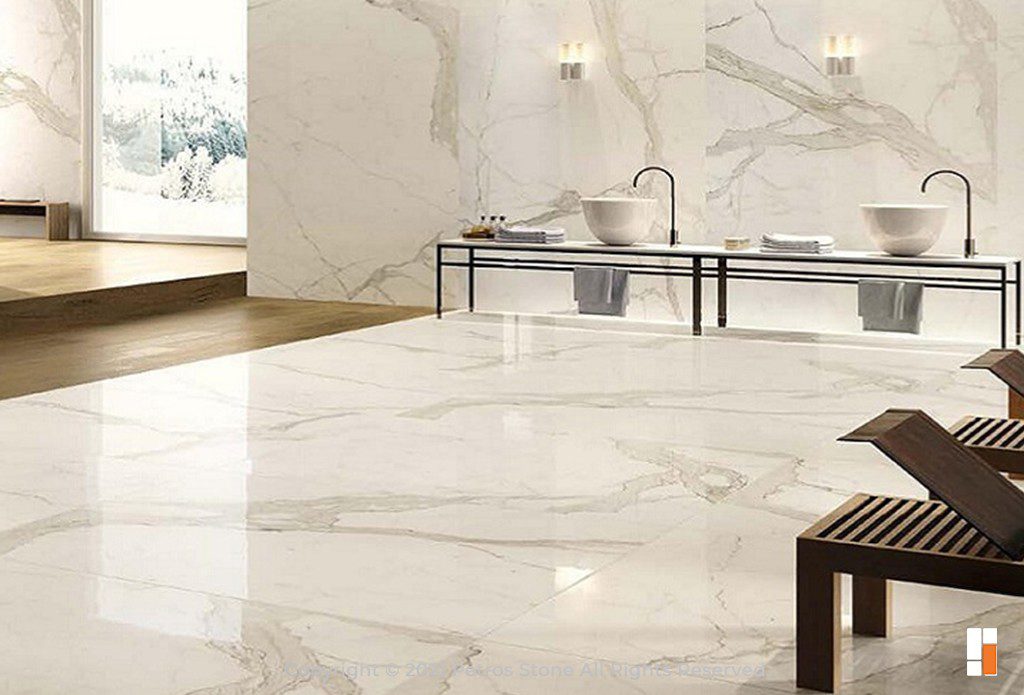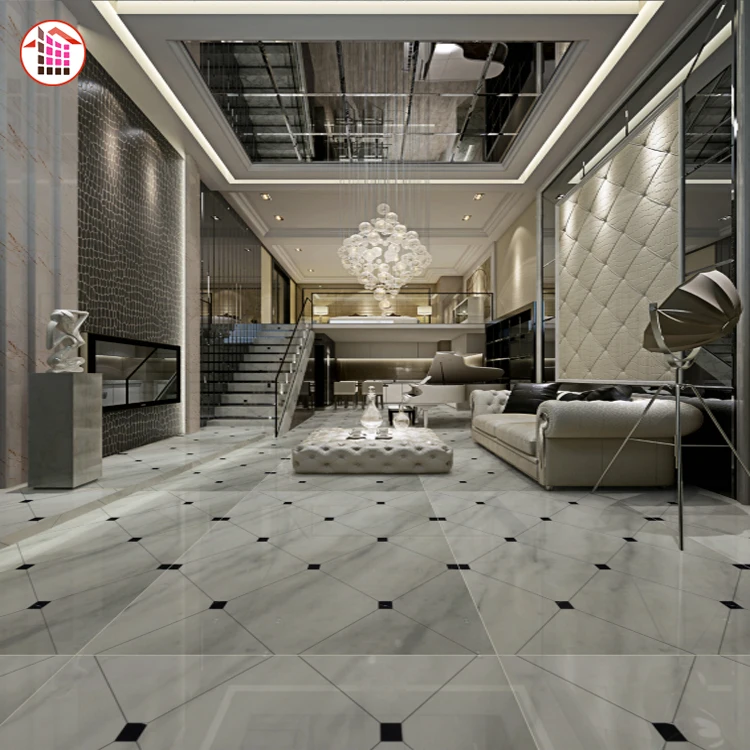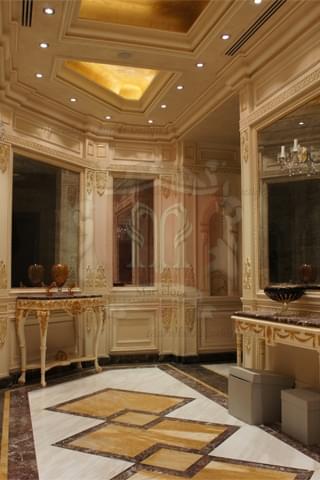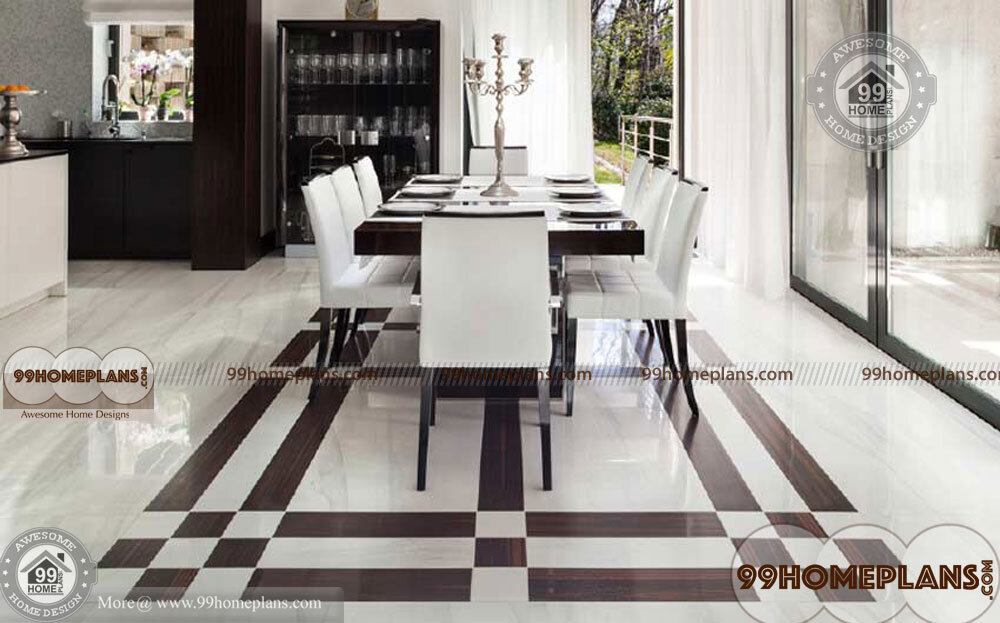Popular Types of Italian Marble for Flooring
Italian marble is renowned for its beauty and elegance, making it a popular choice for flooring in luxury homes and commercial spaces. Here are some of the most popular types of Italian marble for flooring, each offering unique characteristics and aesthetics.
- Carrara Marble Carrara marble is one of the most famous types of Italian marble, known for its white or blue-grey background and soft, feathery veining. Originating from the Carrara region in Tuscany, this marble is highly prized for its timeless appeal and versatility. It’s often used in classic and contemporary settings alike, offering a subtle elegance that complements various interior styles.
- Calacatta Marble Calacatta marble is another highly sought-after Italian marble, distinguished by its bold, dramatic veining on a white background. Unlike Carrara, Calacatta’s veining is more pronounced and often features gold or brown tones, adding a luxurious touch to any space. This marble is ideal for making a statement in entryways, bathrooms, and kitchens, where its striking appearance can be fully appreciated.
- Statuario Marble Statuario marble is revered for its pure white background and distinct, dramatic veining. Found in the same region as Carrara and Calacatta, Statuario is considered one of the most luxurious marbles due to its rarity and striking beauty. It’s often used in high-end residential and commercial projects, where its pristine look enhances the overall sophistication of the space.
- Travertine Travertine, while technically a form of limestone, is often included in discussions about Italian marble due to its historical use and beautiful appearance. This stone features a warm, earthy color palette with natural, porous textures that add a rustic charm to flooring. It’s available in various finishes, including polished, honed, and tumbled, allowing for versatile design applications.
- Botticino Marble Botticino marble, originating from the Lombardy region, is known for its warm beige color and subtle veining. This marble exudes a natural warmth and elegance, making it a popular choice for both traditional and modern interiors. Its soft, neutral tones provide a beautiful backdrop that complements a wide range of decor styles and color schemes.
- Arabescato Marble Arabescato marble is characterized by its white or light grey background with dark, intricate veining patterns that resemble delicate arabesques. This type of marble is highly decorative and adds a touch of artistry to any space. It’s often used for flooring, countertops, and wall cladding, where its unique patterns can be showcased to full effect.

Design Trends in Italian Marble Flooring
Italian marble flooring is synonymous with luxury and sophistication. As design trends evolve, this timeless material continues to adapt, offering fresh and innovative ways to enhance interiors. Here are some of the latest design trends in Italian marble flooring.
Large Format Tiles Large format marble tiles are gaining popularity for their ability to create a seamless and expansive look in a room. These oversized tiles reduce the number of grout lines, resulting in a clean and uninterrupted surface that highlights the natural beauty of the marble. This trend is particularly popular in modern and minimalist interiors where simplicity and elegance are key.
Mixed Marble Patterns Combining different types of Italian marble within a single space is a growing trend. This approach allows for the creation of unique and dynamic flooring designs that showcase the varied colors and veining patterns of each marble type. Mixing Carrara, Calacatta, and Statuario, for example, can result in a visually stunning floor that adds depth and interest to any room.
Geometric and Mosaic Designs Geometric patterns and intricate mosaics are making a comeback in marble flooring design. Using small marble tiles to create complex patterns, such as herringbone, chevron, or hexagonal layouts, adds a touch of elegance and sophistication to the floor. These designs are perfect for areas like entryways, bathrooms, and kitchens, where they can serve as a focal point.
Bookmatched Marble Bookmatching is a technique where two slabs of marble are cut and polished to create mirror images of each other. This trend is gaining traction for its dramatic and artistic effect, often used in high-end residential and commercial projects. When applied to flooring, bookmatched marble creates a striking visual impact that draws attention and adds a sense of luxury to the space.
Matte Finishes While polished marble has always been a classic choice, matte finishes are becoming increasingly popular. A honed or matte finish provides a softer, more understated look compared to the high gloss of polished marble. This trend aligns with the growing preference for natural and organic aesthetics in interior design, offering a contemporary and elegant alternative to traditional finishes.
Eco-Friendly Selections As sustainability becomes a major consideration in design, there is a growing trend towards eco-friendly marble options. This includes sourcing marble from environmentally responsible quarries and using low-impact extraction methods. Additionally, designers are incorporating marble with recycled content and opting for finishes that require fewer chemicals, aligning luxury with environmental responsibility.
Advantages of Using Italian Marble in Your Home
Italian marble is renowned for its beauty and quality, making it a coveted material in home design. Here are some of the key advantages of using Italian marble in your home.
Timeless Elegance Italian marble exudes a timeless elegance that can enhance the aesthetic appeal of any space. Its natural beauty and unique veining patterns make it a classic choice for flooring, countertops, and other surfaces. The luxurious look of Italian marble can elevate the overall design of your home, adding a touch of sophistication that never goes out of style.
Durability and Longevity Italian marble is known for its durability and longevity. When properly maintained, marble flooring can last for decades, providing a long-term investment for homeowners. Its strength and resistance to wear make it an ideal choice for high-traffic areas, such as hallways, kitchens, and living rooms, where durability is essential.
Versatility in Design Italian marble offers a wide range of colors, patterns, and finishes, making it highly versatile in design applications. Whether you prefer the subtle elegance of Carrara, the bold drama of Calacatta, or the warm tones of Botticino, there is an Italian marble to suit every style and taste. This versatility allows homeowners to create unique and personalized interiors that reflect their individual preferences.
Increased Property Value The use of Italian marble in a home can significantly increase its property value. Marble is associated with luxury and high-end design, making it an attractive feature for potential buyers. Investing in marble flooring, countertops, or other surfaces can enhance the market appeal of your home, potentially leading to a higher resale value.
Natural Cooling Properties Italian marble has natural cooling properties, making it a practical choice for homes in warmer climates. The stone’s ability to stay cool underfoot can help regulate indoor temperatures, providing a comfortable living environment. This natural cooling effect can also contribute to energy savings by reducing the need for air conditioning.
Eco-Friendly Material Marble is a natural material, and its use in home design can be an eco-friendly choice. Unlike synthetic materials, marble does not emit harmful chemicals or toxins, contributing to a healthier indoor environment. Additionally, many Italian marble quarries adhere to sustainable practices, ensuring that the extraction and processing of marble have a minimal environmental impact.
Installation Tips for Italian Marble Flooring
Installing Italian marble flooring requires careful planning and execution to achieve a flawless result. Here are some essential tips for a successful installation.
Preparing the Subfloor The first step in installing marble flooring is to ensure that the subfloor is properly prepared. The subfloor must be clean, dry, and level to provide a stable base for the marble tiles. Any imperfections in the subfloor can affect the final appearance and durability of the flooring. Use a leveling compound to correct any uneven areas and ensure a smooth surface.
Acclimating the Marble Before installation, allow the marble tiles to acclimate to the room’s temperature and humidity. Place the tiles in the installation area for at least 48 hours to prevent expansion or contraction after installation. This step is crucial to avoid gaps or cracks in the flooring due to changes in environmental conditions.
Planning the Layout Plan the layout of the marble tiles before starting the installation. Dry-lay the tiles to determine the best arrangement and to ensure that any veining or patterns align correctly. This step allows you to make adjustments and cuts as needed, ensuring a cohesive and visually appealing design. Use spacers to maintain consistent grout lines and achieve a professional finish.
Applying the Adhesive Use a high-quality adhesive specifically designed for marble flooring. Apply the adhesive evenly to a small section of the subfloor using a notched trowel. Press the marble tiles firmly into place, ensuring good contact with the adhesive. Work in small sections to prevent the adhesive from drying out before the tiles are set. Use a rubber mallet to tap the tiles gently and ensure they are level.
Grouting and Sealing After the tiles have been set and the adhesive has cured, apply grout to the joints between the tiles. Use a grout float to spread the grout evenly, filling all gaps. Wipe away excess grout with a damp sponge before it dries. Once the grout is fully cured, apply a high-quality sealer to the marble surface to protect it from stains and moisture. Re-seal the flooring periodically to maintain its protective barrier.
Final Touches Inspect the installed marble flooring for any imperfections or gaps. Make any necessary adjustments to ensure a flawless finish. Clean the surface thoroughly to remove any residue or debris from the installation process. Install baseboards or trim to cover the edges of the flooring and complete the look. Regularly maintain and clean the marble to preserve its beauty and longevity.
Maintaining and Caring for Italian Marble Floors
Italian marble floors are a stunning addition to any home, but they require proper care and maintenance to keep them looking their best. Here are some tips for maintaining and caring for your Italian marble floors.
Regular Cleaning Regular cleaning is essential to keep marble floors looking pristine. Sweep or vacuum the floor daily to remove dirt and debris that can scratch the surface. Use a soft-bristle broom or a vacuum with a hard floor setting to avoid damaging the marble. For deeper cleaning, use a damp mop with a pH-neutral cleaner specifically designed for marble. Avoid using acidic or abrasive cleaners that can etch or dull the surface.
Spill Management Marble is porous and can absorb liquids, leading to stains. Promptly wipe up any spills with a soft cloth to prevent staining. For stubborn stains, use a poultice made from a mixture of baking soda and water. Apply the poultice to the stain, cover it with plastic wrap, and let it sit for 24 hours before wiping it away. This method can help draw out the stain without damaging the marble.
Sealing the Marble Sealing is an important step in protecting marble floors from stains and moisture. Apply a high-quality marble sealer according to the manufacturer’s instructions. The sealer creates a protective barrier that reduces the marble’s porosity and enhances its resistance to staining. Re-seal the marble periodically, depending on the amount of foot traffic and exposure to spills.
Preventing Scratches and Etching Protect your marble floors from scratches and etching by using rugs or mats in high-traffic areas and under furniture. Place felt pads under furniture legs to prevent scratches when moving items. Avoid dragging heavy objects across the floor, and use caution when placing sharp or abrasive items on the marble surface. These precautions will help preserve the marble’s smooth and polished appearance.
Dealing with Etching Etching occurs when acidic substances, such as lemon juice or vinegar, come into contact with marble, causing dull spots or discoloration. To address etching, use a marble polishing powder and a soft cloth to gently buff the affected area. Follow the manufacturer’s instructions for the best results. In severe cases, professional restoration may be necessary to restore the marble’s original shine.
Professional Maintenance Periodic professional maintenance can help keep your marble floors in top condition. Consider hiring a professional marble cleaner and polisher to perform deep cleaning, polishing, and sealing. Professional services can address any issues that regular cleaning cannot, ensuring that your marble floors remain beautiful and durable for years to come. Regular professional maintenance is an investment in the longevity and appearance of your Italian marble floors.
Pin on Best Italian Marble Supplier
Italian Marble Flooring-Types and Features CBVAR
Luxury Marble Floor Design by Italian Giallo Siena
Italian marble flooring design
Italian Marble or Indian Marble – Which One Do You Choose?
Italian Marble Flooring Photos – Best Patterns – Designs for Home
Italian marble flooring design price, name, and information
Italian Marble finish for Living Rooms
Italian Marble Flooring-Types and Features
Italian marble flooring inlays details – Top Interior Designer
Related Posts:













